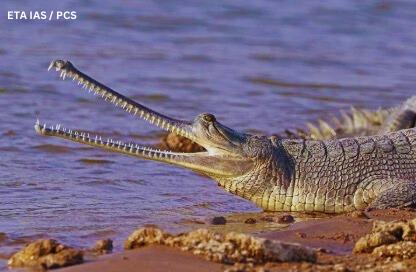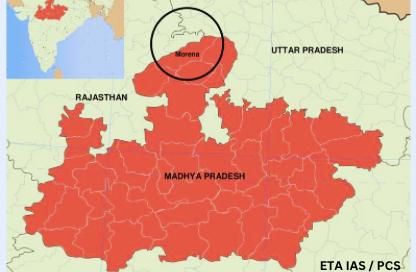CONTEXT: The Chief Minister of Madhya Pradesh has introduced ten gharials into the Chambal River at the National Chambal Gharial Sanctuary, located in the Morena district of Madhya Pradesh, in an effort to enhance the gharial population.
About Gharial
- Species Overview: The gharial is a type of crocodilian known for its elongated snout and primarily fish-based diet.
- Name Origin: The term “gharial” comes from the Hindi word “ghara,” meaning pot or vessel, referring to the bulbous tip of adult male gharials’ snouts, which resemble an inverted pot.
- Key Characteristics:
- Slender snouts with sharp, interlocking teeth.
- Males typically range from 3 to 6 meters in length, while females are smaller, measuring 2.6 to 4.5 meters.
- Fish make up the majority of their diet.
- Habitat Preferences: Gharials prefer habitats with sandbanks, sandbars, and islands, which are ideal for basking and communal nesting.

Distribution
- Primary Habitat: The largest population of gharials can be found in the freshwater river systems of India, particularly in the Chambal River, a tributary of the Yamuna River.
- Other Locations: Smaller populations exist in Pakistan, Nepal, and the upper Brahmaputra region of Bangladesh.
- Extinct Areas: Gharials are likely extinct in Myanmar and Bhutan.
Ecological Importance
- Gharials help maintain the health of river ecosystems by consuming carrion, which aids in keeping the water clean and balanced.
Threats
- Historical Threats: Overhunting for skins, trophies, eggs, and use in traditional medicine posed significant risks to their population.
- Modern Challenges: Contemporary threats include:
- Dam construction and irrigation canals disrupting their habitat.
- Siltation, river course alterations, embankments, and sand mining.
- Pollution and entanglement in fishing nets.
Conservation Status
- IUCN Red List: Gharials are classified as Critically Endangered.
- Legal Protection: They are listed in CITES Appendix I and are protected under Schedule I of the Wildlife Protection Act of 1972.
Gharial Conservation
Madhya Pradesh as the “Gharial State”: Madhya Pradesh is known as the “gharial state” of India, housing over 80% of the country’s gharial population due to decades of focused conservation efforts.
Captive Breeding and Sanctuaries:
From 1975 to 1982, India established 16 captive breeding and release centers, alongside five designated gharial sanctuaries to ensure the survival of the species.Key Conservation Locations:
Gharials are now primarily found in five key sanctuaries:- National Chambal Sanctuary
- Katerniaghat Sanctuary, Uttar Pradesh
- Chitwan National Park, Nepal
- Son River Sanctuary, Madhya Pradesh
- Satkosia Gorge Sanctuary, Odisha
Conservation Initiatives
Captive Breeding and Monitoring: The implementation of captive breeding programs and ongoing population monitoring help track and sustain gharial numbers.
Community Involvement: Local communities are actively engaged in habitat conservation efforts and educational outreach to promote awareness and reduce human-wildlife conflict.
Addressing Threats: Conservation efforts are focused on mitigating threats such as sand mining and other human activities that disrupt the gharial’s habitat.
Ecosystem Protection: The protection of river ecosystems and the restoration of sandbanks are vital to maintaining suitable conditions for gharials to thrive.
National Chambal Gharial Sanctuary
Location: The sanctuary is located along the Chambal River, at the convergence of Rajasthan, Madhya Pradesh, and Uttar Pradesh, and protects a 435-kilometer stretch of one of India’s most pristine rivers.
Biodiversity:
- Birds: The sanctuary is home to over 290 species of birds, including the rare Indian Skimmer, which represents 80% of the national population.
- Other Notable Fauna:
- Red-crowned roof turtle
- Endangered Ganges river dolphin
- Mugger crocodile
- Smooth-coated otter
- Striped hyena
- Indian wolf
This sanctuary is a critical habitat not only for gharials but also for a diverse range of wildlife, making it an essential conservation site.

Chambal River
Origin: The Chambal River originates from the Vindhya Range in Madhya Pradesh.
Flow and Path:
- It flows in a north-northeast direction through Madhya Pradesh, forming a natural border between Rajasthan and Madhya Pradesh.
- The river then shifts southeast and merges with the Yamuna River in Uttar Pradesh.
Main Tributaries:
- Banas River
- Kali Sindh River
- Sipra River
- Parbati River
Geographical Features:
The lower stretch of the Chambal River is notable for its 16-kilometer expanse of badland gullies, which have been formed due to accelerated soil erosion, giving the area a unique and rugged landscape.
PRELIMS PRACTISE
Q.Which of the following is true regarding the reproductive behavior of gharials?
A) Gharials lay their eggs in burrows near the riverbanks and leave them unattended.
B) Gharials exhibit extensive parental care, with both parents guarding the nest.
C) The male gharial builds large nests and takes responsibility for incubating the eggs.
D) Gharials have a specific mating season that is linked to the monsoon rains.
